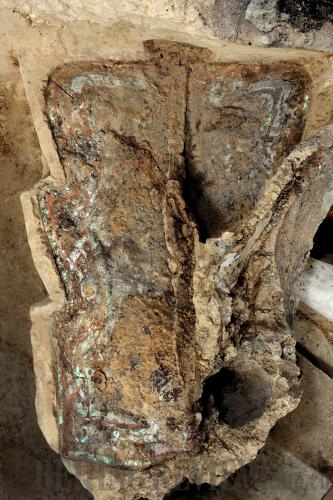|
 |
|
NEW FINDINGS: Archaeologists unearth a colored shield for the first time in a pit of the Terracotta Warriors and Horse Museum, giving researchers a new glimpse into the ancient Chinese army (XINHUA) |
The mystery of how the sculptures were arranged in formation also drew the attention of archaeologists.
At the excavation site, most terracotta warriors face the east, while only the soldiers on the outside line face the north.
"Archaeologists speculated in the past that the ancient Qin army had a wing guard to prevent enemy attacks from the side. This excavation confirmed it," Yuan said.
The Qin Dynasty was one of the strongest regimes in history. The unearthed terracotta warriors reveal an era of unrivaled military strength.
Entertaining the emperor
Along with the terracotta warriors, a number of statues depicting entertainers or acrobats have also been found in a neighboring pit. The figures have a pink finish, with red, purple and black patterns. The largest of the performers was 2.5 meters high, with 32-cm-long feet.
"From the pit located in the southeast part of the mausoleum, we unearthed 41 figures that were different from the warriors. From their gestures, we can judge that they were giving a performance," said Shen Maosheng, head of the archaeological team for the most recent excavation.
According to Shen, these life-sized pottery figures with funny and exaggerated gestures are probably performers who entertained guests at the emperor's palace. The excavation of acrobats marks the finding of a new kind of terracotta figures inside the mausoleum.
Evidence of burning
Archeologists have discovered evidence of burn marks on some of the unearthed pottery artifacts, suggesting damage once inflicted on the terracotta warriors for unknown reasons.
For a long time, there were two views on the burning of the warriors and horses: One was that it was spontaneous combustion that was caused by biogas produced by wood and other organic materials inside the pit; and the other was that it was a deliberate act. During this excavation, archaeologists found evidence confirming that the fire was intentional.
Archeologists have found blackened remains and red earth suggesting that the warriors may have been burned in a large fire in the pit. A notable detail is that pottery figures near corridors and doors showed the worst damage. It is possible that their proximity to air vents left them most exposed to the flames.
"Today, some archaeologists speculate that Xiang Yu (232-202 B.C), one of the leaders who overthrew the Qin Dynasty, and his soldiers may have set fire to the pit," said Shen.
Xiang had a deep hatred for Qinshihuang because his country was defeated and his family members were killed by Qin's army. When Xiang occupied Xianyang City (near Xi'an), capital of Qin, in 206 B.C., four years after the emperor was dead, he may have raided the tomb of Qinshihuang. Many Chinese chronicles left records of the historic event, and the new findings may verify those records and confirm archaeologists' speculations, Yuan said.
According to the archeological team, the current excavation will be completed within two or three years. In the coming years, researchers will continue to protect the precious ancient artifacts and attempt to restore their erstwhile color.
Qinshihuang and His Legacy
Emperor Qinshihuang (259-210 B.C.) came to the throne of the Qin Kingdom at the age of 13, and took the helm of the state when he was 22. By 221 B.C., he had annexed the six rival states of Qi, Chu, Yan, Han, Zhao and Wei and established the first unified central state in Chinese history.
Qinshihuang conscripted about 700,000 convicts to build his mausoleum soon after taking the throne to ensure his peaceful and eternal sleep. It took 38 years to complete the whole project. As Chinese chronicles note, Qinshihuang's tomb was filled with a great number of priceless treasures and designed with numerous traps against robbers. Despite some past robbery attempts, most of the mausoleum is well preserved underground. The tomb may hold even more secrets yet to be excavated.
The mausoleum of Qinshihuang and the terracotta warriors are among the world's greatest archaeological discoveries, and were added to the World Heritage List of the United Nations Education, Scientific and Cultural Organization in 1987.
The Terracotta Warriors and Horses Museum of Qinshihuang's Mausoleum was first opened to the public in 1979. There is an exhibition of the terracotta warriors currently on display in New York's Discovery Times Square museum of the United States. The exhibition will end on August 26.
Email us at: baishi@bjreview.com | 